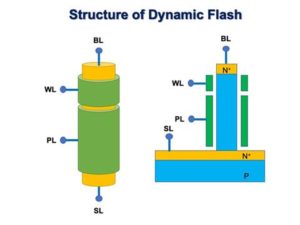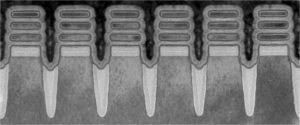Chip shortage and foundry activity continue to make headlines. Tesla is reportedly considering paying in advance for chips to secure its supply, and is said to be even exploring the acquisition of a semiconductor fab. GlobalFoundries is reportedly working with Morgan Stanley on an initial public offering that could value the foundry at about $30 billion. Let’s now move to some process technology and EDA updates.
Vertical nanowire-based memory promises 4X DRAM density without special materials
Singapore-based Unisantis unveiled the developments of its Dynamic Flash Memory (DFM) technology at the recent IEEE International Memory Workshop. According to the company, DFM offers faster speeds and higher density when compared to DRAM or other types of volatile memory. DFM is also a type of volatile memory, but since it does not rely on capacitors it has fewer leak paths, and it has no connection between switching transistors and a capacitor. The result is a cell design with the potential for significant increases in transistor density. Additionally – as it offers ‘block erase’ like a Flash memory – DFM reduces the frequency and the overhead of the refresh cycle and can deliver significant improvements in speed and power compared to DRAM. Based on TCAD simulation, Unisantis claims that DFM can potentially achieve a 4X density increase compared to DRAM. So, while the scaling of DRAM has almost stopped at 16Gb, DFM could be used to build 64Gb memory devices. Unisantis points out that unlike the so-called ‘emerging memory technologies’ (MRAM, ReRAM, FRAM, PCM), its Dynamic Flash Memory does not require using additional materials on top of a standard CMOS process. DFM was developed by Unisantis with the principles of its patented surround gate transistor (SGT) technology, also referred to in the semiconductor industry as a vertical nanowire transistor. According to the company, the benefits of this technology include improved area density, compared to planar and FinFET transistors; reduced leakage power, due to the strong electrostatic control of the surrounding gate to the transistor channel; and the possibility of optimizing the transistor width and length for different power/performance combinations. Unisantis is working on SGT technology in collaboration with Belgian research institute Imec.









